Spooky Delights: Halloween in Japan
As the leaves change color and the cool autumn breeze sweeps through Japan, major cities across the country may (or may not) lean into the season. One such way that cities such as Tokyo do this is to transform into veritable Halloween wonderlands. From eerie events to creepy culinary delights, Halloween offers a unique blend of traditions and modern celebrations.
Join me as we explore the spine-tingling and delectable side of Japan during the spookiest season of the year. This article is designed to be your guide to experiencing Halloween, particularly in Tokyo, but some of it can also apply to Osaka and other cities. Whether you’re a resident or planning a future visit, you’ll discover the best Halloween events, treat, and unique traditions that Japan has to offer.
Creepy Costumes and Shibuya Chaos: Until 2023, Tokyo’s most iconic Halloween celebration took place in Shibuya. Every year, thousands of locals and visitors gathered in their most creative costumes to parade through the famous Shibuya crossing. The energy and creativity on display were truly remarkable. Alas, heavy crowds resulted into heavy litter and other disturbances, and this year Shibuya will be Halloween-free.
However, other areas in Tokyo have been holding smaller, localized events geared more towards families or small groups. Here you can see creative costumes and get a more relaxed taste of the festiva atmosphere. Be sure to bring your camera to capture the impressive outfits and join in on the fun.
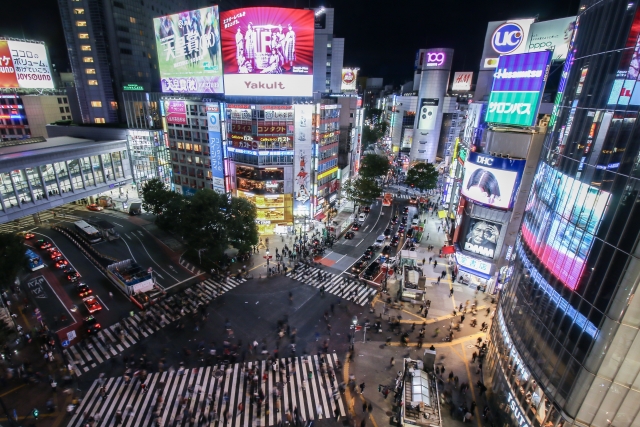
Photo by RyoF0610
Ghoulish and Interesting Goodies: Tokyo’s bakeries and dessert shops get into the Halloween spirit with a range of spooky treats. From Jack-o’-lantern cookies to matcha-flavored mummies, the city’s sweet offerings are as delightful as they are hunting. Don’t forget to try pumpkin-flavored treats, a Japanese autumn staple.
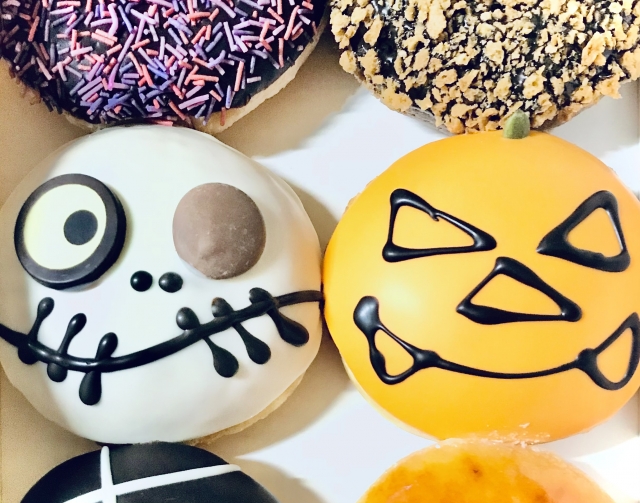
Photo by Yupote@VN
Haunted Theme Parks: Japanese Theme parks, including Tokyo Disneyland and Universal Studios Japan, go all out for Halloween. They offer special Halloween-themed parades, decorations, and events that are fun for visitors of all ages. Explore the haunted houses and enjoy exclusive Halloween merchandise.
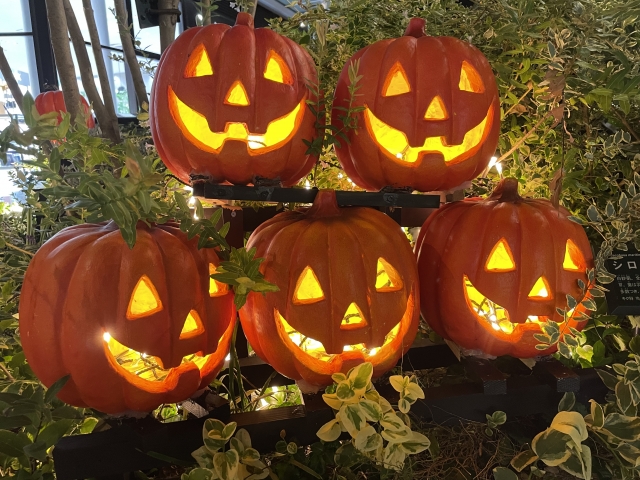
Photo by Choco Milk
Traditional Ghostly Tales: While modern Halloween is a relatively recent addition to Japanese culture, the country has a rich history of ghost stories and supernatural folklore. This is the perfect time to dive into traditional tales of spirits and supernatural occurrences. Consider visiting locations with historical significance, such as Kyoto’s haunted houses and temples.

Photo by mikikkumama
Halloween in Japan is a fantastic blend of traditional Japanese culture and contemporary celebrations. From costumed spectacles around Tokyo to mouthwatering sweets and haunted theme parks, there’s something for everyone. So, done your most creative costume and embrace the Halloween spirit in this unique and vibrant country.
Photo Credits
Additional photos by RyoF0610 , Yupote@VN , Choco Milk & mikikkumama
All other content (text) created by the original author and © 2023 MUSUBI by Borderlink
Top photo: marumaru3 on PhotoAC
If you come to Japan at any point in your life you will likely have someone ask if you have been to an onsen. As someone from the USA its pretty jarring to imagine having to go into a place and be naked with other people. Sure there are the locker rooms of your youth where horseplay in the locker room showers was the norm. At least that’s what movies like “Breakfast Club” or “Sixteen Candles” would seem to have you believe.
I personally didn’t have those sort of communal bathing experiences until I came to Japan where the onsen culture is rich and varied. At first hesitant I am now one of the many onsen fans and have converted many of my friends into onsen fanatics as well. It can be scary at first but once you try it once you’ll want to be one of the many onsen lovers , traveling to the many far flung and remote bathing locations of Japan. Taking in the sights , sounds and watching time slip away along with all your worries.
Here are some tips for getting started with onsens.
Researching the rules and etiquette of an onsen before your visit is essential to avoid any uncomfortable situations. For example, it is customary to wash your body before entering the bath, so make sure you know how to properly use the shower and where to place your towel. Additionally, be aware that most onsens don’t allow any clothing, jewelry or swimsuits inside the bath, so you’ll need to remove all of these before entering. Knowing what to expect beforehand can help ease any anxiety and allow you to enjoy the experience more fully.
If you’re not comfortable being naked in front of strangers, consider staying at a ryokan that offers private onsens. These rooms are typically equipped with their own small hot spring baths, allowing you to enjoy the experience with only your friends or family members. This option is usually more expensive than public onsens, but it can be worth it if you want to experience the benefits of onsens without feeling self-conscious.
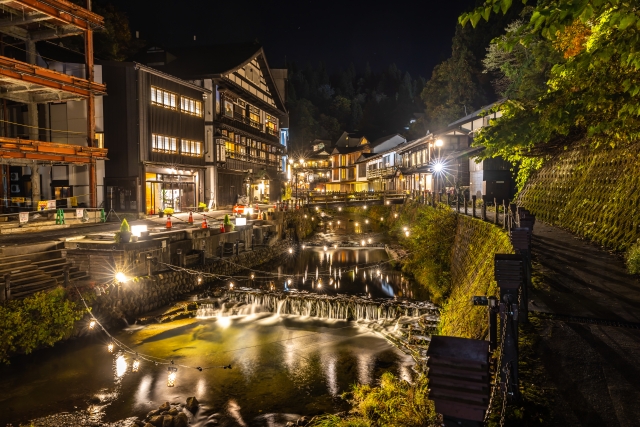
Photo by スプププ
Bringing a friend or a partner who has already experienced onsens can help ease your anxiety and make the experience more enjoyable. They can show you the ropes and answer any questions you may have. Moreover, sharing the experience with someone else can help make it feel less intimidating and more relaxing.
If you’re still hesitant about trying an onsen, start with a small onsen or a public bath that is less crowded. This can help you ease into the experience and get comfortable with being naked in front of strangers. You can also consider visiting a mixed-gender onsen, as these are often less intimidating for first-timers.
If you feel uncomfortable in the communal areas, bring a book or a magazine to read while you’re soaking in the bath. This will help you relax and take your mind off your surroundings. Additionally, many onsens have private resting areas or outdoor gardens where you can relax after your bath. So, don’t be afraid to take a break and enjoy the scenery around you.
Onsen culture is deeply ingrained in Japanese society, and it has been a part of their lifestyle for centuries. The Japanese believe that onsen baths have therapeutic properties and can cure a variety of ailments, including muscle and joint pain, skin conditions, and stress. The mineral-rich hot springs found in onsens are said to have healing properties that help relax and rejuvenate the body.
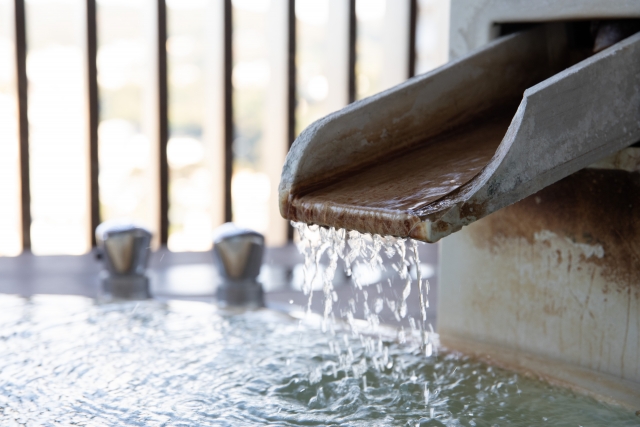
Photo by えこだん
Apart from the health benefits, onsen culture also promotes socializing and communal bonding. Many onsens have spacious common areas where guests can relax and mingle with other visitors while enjoying a drink or a snack. The relaxed atmosphere of onsens makes them an ideal place for visitors to experience traditional Japanese culture and interact with the locals.
The onsen experience is not just about the hot springs and the communal baths. Many onsens are located in scenic locations surrounded by mountains, forests, or by the sea, offering breathtaking views to their visitors. Some onsens are even located in the heart of cities, allowing visitors to enjoy the contrast between the busy urban environment and the peaceful atmosphere of the hot springs.
Onsens come in various shapes and sizes, ranging from rustic outdoor baths to luxurious indoor spas, providing something for everyone’s taste and budget. Visitors can choose to stay at a traditional Japanese inn, called ryokan, which often includes access to a private onsen, or they can visit one of the many public onsens scattered throughout the country. Whatever the choice, the magic of Japanese onsens is an experience that visitors will never forget.
If you’re ever fortunate enough to find yourself in Japan, you may find yourself face to face with the strange and wonderful world of onsens. At first, the idea of being naked in front of strangers may seem daunting, but fear not! With a little research, an open mind, and perhaps a trusted friend by your side, you can experience the magic of these rejuvenating hot springs for yourself.
As the old saying goes, “When in Rome, do as the Romans do.” And in Japan, that means embracing the cultural significance of onsens. These baths offer not only a chance to unwind and relax, but also a glimpse into a unique aspect of Japanese life that has been cherished for centuries. And for those who may be hesitant, remember that it’s perfectly normal to feel a little anxious before trying something new. But as with all things, practice makes perfect.
So, whether you choose to soak in a private onsen, start small, or bring a good book to read, know that you’re not alone. Countless travelers have braved the waters before you and emerged feeling refreshed and rejuvenated. Who knows? You may even find yourself joining the ranks of the onsen enthusiasts, traveling far and wide to experience the best of what these hot springs have to offer.
Photo Credits:
Top photo: marumaru3 on PhotoAC
Additional photos by スプププ and えこだん
All other content (text) created by the original author and © 2023 MUSUBI by Borderlink
Japan, known for its rich culture, technological advancements, and unique traditions, has witnessed significant changes in lifestyle, especially among the younger generation. With its strong influence on pop culture, fashion, and technology, young adults in Japan embrace a lifestyle that is a blend of tradition and modernity.
One of the most noticeable aspects of modern-day Japanese lifestyle is the pervasive presence of technology. Japanese youth are renowned for their affinity towards the latest gadgets, smartphones, and gaming devices. With Japan being at the forefront of technological innovations, young adults are early adopters of cutting-edge technologies, often influencing global consumer trends.
This obsession with technology has given rise to a new era of interconnectedness among Japanese youth, where social media platforms, video sharing apps, and online gaming communities play a significant role in their daily lives.
Furthermore, the fashion industry in Japan is a vibrant and ever-evolving one that captivates the younger generation. From avant-garde street fashion in Harajuku to sophisticated high-end brands in upscale districts like Ginza, young adults in Japan have an eclectic taste in clothing.
Moreover, the practice of cosplaying, which involves dressing up as characters from anime, manga, and video games, has become increasingly popular among Japanese youth. This phenomenon not only reflects their deep-rooted love for fictional characters but also serves as a way for young adults to express their unique individuality and creativity.
Japanese society places great importance on education, and this has a significant impact on the lifestyle of young adults. Students in Japan often exhibit a strong work ethic and a dedication to their studies. The intense competition in the education system drives many young adults to allocate a significant amount of time towards academics, with long hours spent in schools and additional tutoring programs.
As a result, youngsters face immense pressure to excel academically and secure admissions into prestigious universities, which can sometimes negatively impact their mental and physical well-being.
Contrary to popular belief, not all young adults in Japan conform to the stereotype of the “workaholic.” Increasingly, this generation is prioritizing work-life balance and seeking alternatives to the traditional corporate lifestyle. Many young Japanese adults are opting for part-time or freelance work, allowing them greater flexibility in managing their personal lives and pursuing their passions. This shift in attitude towards work signifies a departure from the rigid salaryman culture that has long defined the Japanese workforce.
As with any society, social challenges are also prevalent among young adults in Japan. The pressure to conform, strict societal expectations, and increasing social isolation are issues that this generation faces. However, Japanese youth are finding creative ways to combat these challenges.
For instance, there is a growing trend of joining interest-based communities and clubs to foster connections with like-minded individuals. Additionally, more young adults are embracing self-exploration and personal growth through solo travel, meditation, and engaging in mindfulness practices.
In conclusion, modern-day Japanese lifestyle has witnessed significant changes among young adults. The ubiquitous presence of technology, the influence of fashion and pop culture, the pursuit of education, and the desire for work-life balance all shape the lives of Japanese youth.
While facing various societal challenges, this generation is carving out a distinct path, blending tradition and modernity, as they strive to lead fulfilling lives in an ever-evolving society.
Photo Credits
All other content (text) created by the original author and © 2023 MUSUBI by Borderlink
When struck with homesickness, what is your go-to comfort source? Life as an expat can be exciting and adventurous, of course; but can also come with some unique experiences, such as homesickness. Personally, homesickness doesn’t necessarily mean I wish to return to my home country – but it means a strong desire to find comfort through things that were once familiar in my every day life prior to living abroad.
There are multiple senses we can tap into to find sources of comfort: through music, a familiar art craft or hobby, or even food. Finding familiar foods while living abroad can be a great source of comfort for expats – especially when feeling homesick – so that’s why I would like to share a favorite restaurant that has brought a sense of comfort and familiarity to me, in hopes that it will also bring you the same nostalgia I have felt while visiting it. At the very least, I hope it might be an appealing destination for anyone craving some delicious Mexican food while living in Japan.
Why Comfort Food Helps
Most can probably agree that we find comfort in specific foods from our childhood or home country. The nostalgia and specific memories that certain foods can bring back is an endorphin boost that many would seldom refuse. Eating Mexican food in Japan that reminds me of my mom’s home cooking, along with the nostalgia of my childhood memories connected with certain foods, helps ease the occasional homesickness encountered while living abroad.
Being predominantly of Mexican ethnicity, being from California in the USA (where is arguably the second-best only to Mexico in terms of places to find authentic Mexican food), and having an amazing mom who cooked homemade Mexican food from scratch throughout my life, I admit to being a bit harsh in judging Mexican food establishments in general. However, I think I have finally found a restaurant that may be close to authentic as you can find in Japan.
Of course, not all of us grew up with a predominantly Mexican background, and therefore may not have a strong nostalgic association or distinct memories connected to Mexican food – but I think we can all agree that we all typically enjoy a delicious meal. So whether you’re simply looking to try a new delicious restaurant, or are hoping to invoke a sense of nostalgia through Mexican food, I would like to highlight a favorite establishment of mine.
Introducing Rico
Without further ado, I introduce Rico Mexican Bar. This establishment is located in Funabashi City, in Chiba prefecture. It is only a short 5-minute walk from Funabashi Station via the Chuo-Sobu Line, or just 2 minutes from Keisei Funabashi Station via the Keisei Line. Being located in such a busy section of Funabashi City, there are a wide range of establishments nearby Ricos; but not to fret, because it’s easy to find from its street view due to its window decor on the second floor that displays “Mexican” all capitalized in green, white, and red to represent the Mexican flag.
Once you walk in, you can see various Mexico inspired decorations, including photos, Sugar Cane Skulls, and alcohol bottles that are strategically displayed around the establishment. A large projection screen is typically playing Lucha Libre fights, along with some Spanish music playing softly in the background – so whether you decide to take a window seat, grab a seat at their bar, or otherwise, the atmosphere is cosy, open, and inviting.

(Photo Credit: メキシカンバルRICO船橋店 via Google Maps)
If the atmosphere of the establishment isn’t enough to draw you into a feeling of being deported into an enclave of Mexico within Japan, then their menu definitely has a wide selection of foods that can help aid in transporting you and your tastebuds into a new world bite-by-bite. It might be a safe assumption that the selection of choices on Rico’s menu is large enough that there is something for everyone to enjoy. From appetizers, to sides, salads, tacos, main dishes, chicken rotisseries, and desserts – there are so many options that you won’t go home disappointed, but wishing you had the ability to eat even more, if your stomach allowed for it.
As a person who does not eat meat or fish, it can be difficult to eat out in Japan, due to the lack of vegetarian and vegan-friendly options in most food establishments in the country – but if that is a concern, there are some meatless options, and the staff are very accommodating if you ask for a dish without meat in it.
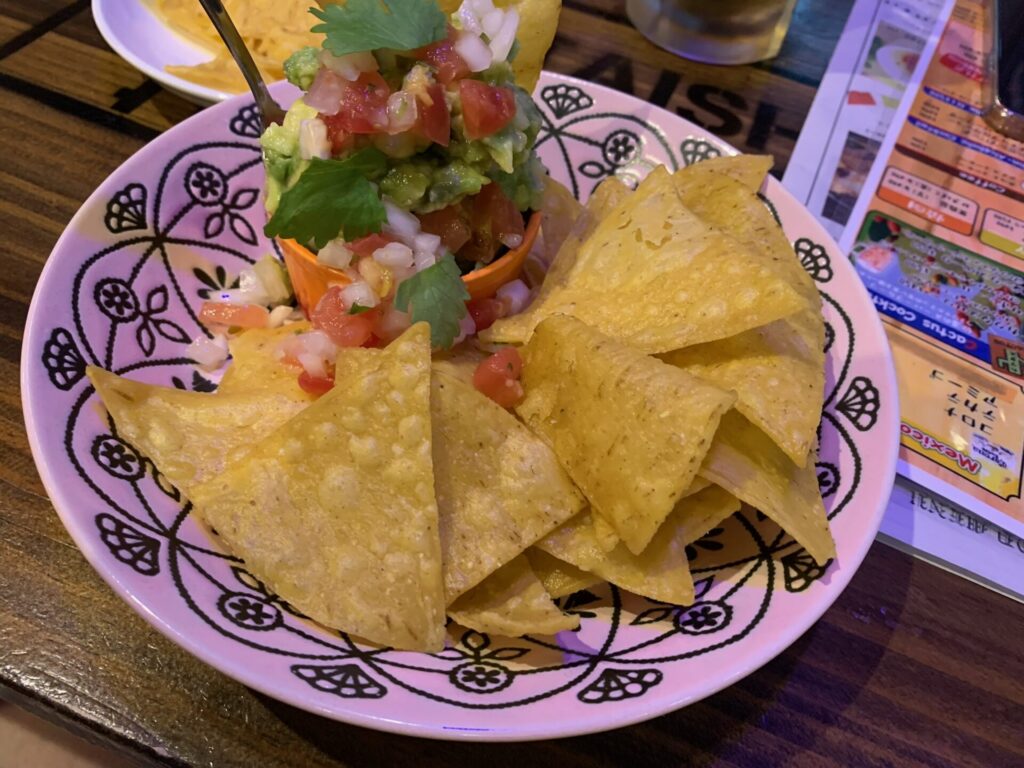
(Photo credit: Jessica Takeuchi)
So How About That Food?
To start, you will be given a serving of chips and guacamole as ‘service’ – or a complimentary part of your meal – while the staff await your order or prepare your drinks, and will give you a chance to look over the menu.
Now, I’d like to recommend some of the foods I typically like to order when I visit Rico. For appetizers, I would suggest trying the jalapeño fritters (or Jalapeño poppers). They are usually only two per serving, so I typically order two servings because one serving is simply never enough. Additionally, nachos are on the appetizers menu; but they are so large that – even sharing amongst four people – the nachos can be quite filling. Pace yourself to keep room in your stomach for the main dish, if you ordered one. Tacos are a must at Ricos.
Whatever tacos you choose, you will not be disappointed. I personally have tried their vegetable tacos, and have eaten with others who have tried other tacos on the menu such as beef or chicken tacos. The tacos are so delicious and freshly cooked, that not one morsel or crumb is ever spared. Unfortunately, we have never ordered dessert at Ricos. By the time we finish our tacos, we are so full that we do not dare to eat another bite – so I can’t vouch for their dessert menu, but I would not be opposed to trying it in the future to recommending others to try out their desserts.
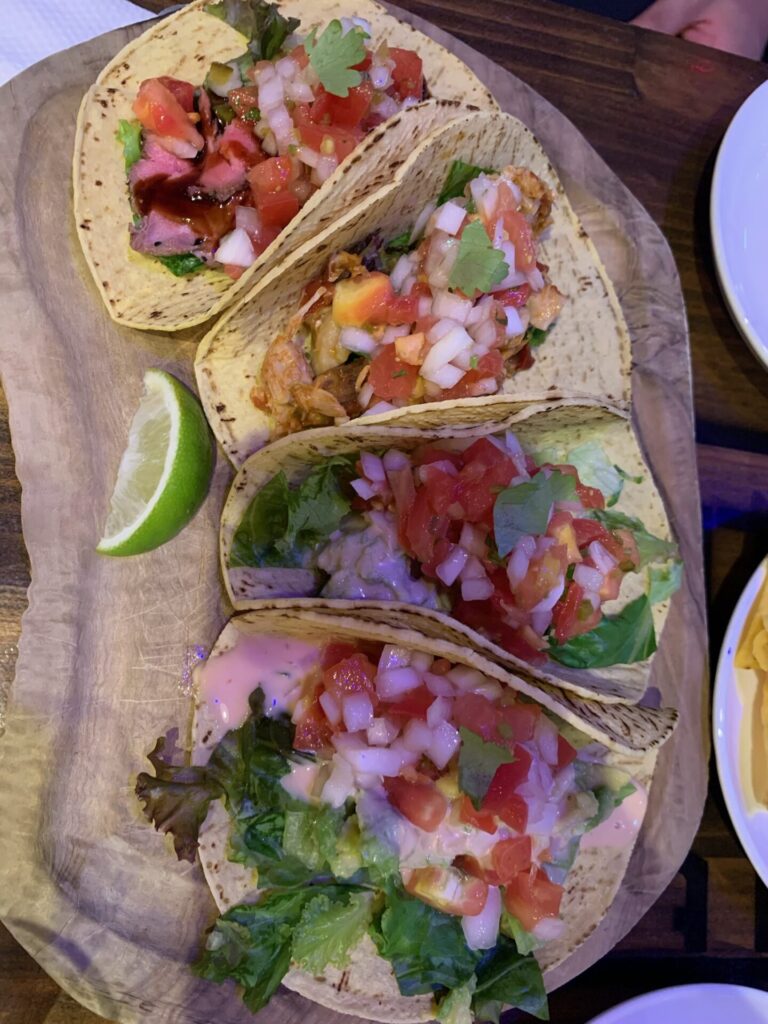
(Photo credit: Jessica Takeuchi)
Conclusion
Whether you’re looking to try a new food establishment, or like me are very harsh on judging the authenticity of Mexican food, Rico Mexican Bar is a place I encourage all to visit. The atmosphere will allow you to temporarily transport yourself into a small Mexican enclave within Funabashi City. This restaurant and bar has helped me battle moments of homesickness, and brought me joy through its delicious meals – so I hope it can bring joy to others as well.
Whether you’re feeling homesick, wanting to try a new restaurant, or looking to find authentic (or close to authentic) Mexican food in Japan, Rico is a place that can lift your spirits and fill your belly to your content. Be forewarned, it is busy most weekends, so I would highly recommend to make a reservation if you would like to avoid a long waiting time. Either way, it would definitely be worth the wait! So, why not give it a try? If you do go to Rico, I’d love to know what you think.
ACCESS:
Photo Credits
Restaurant interior photo provided by メキシカンバルRICO船橋店
All additional images taken and provided by Jessica Takeuchi, used with permission.
All other content (text) created by the original author and © 2023 MUSUBI by Borderlink
Welcome again to Best of MUSUBI, where we revisit articles from the past and breath new life into them with updated information and photos!
Before I came to Japan, I had recently started to become more health-conscious. I was in my late twenties and wanted to have a lifestyle change and be fit while I was still young. Staying healthy and fit does wonders for one’s self esteem and has the added benefit of combating depression, laziness, and other sickness ailments. To do this I had joined the gym, changed my diet, and my daily activities. Moving to Japan was already a culture shock in itself, due to different foods, different health culture, and changes in the kind of available transportation.
Coming from Los Angeles, I had to vastly change what I eat daily in Japan. The two places have a completely different selection for foods. Los Angeles leans heavily on the side of Mexican cuisine while Japanese food has a wide variety of seafood and meats with rice as a base.
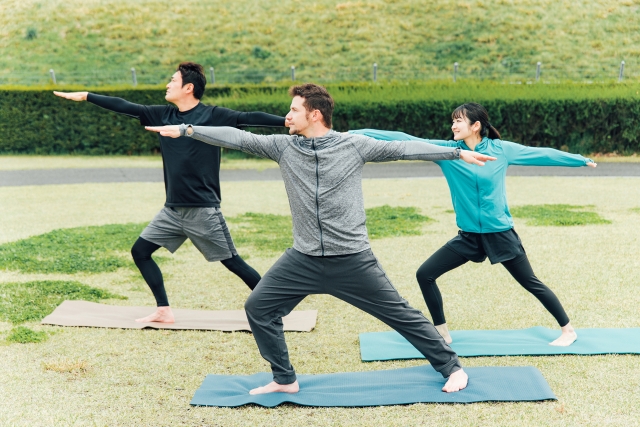
Photo by a FineGraphics
Japan is one of the healthiest countries in the world, but even they have a list of delicious, unhealthy foods that are hard to avoid such as ramen, fried convenience store foods, okonomiyaki and more. Luckily, their list of healthy foods is even larger, such as sushi, grilled fish, natto, vegetables, tofu etc. The supermarkets have similar layouts and designs to American supermarkets so shopping is not a challenge.
The primary challenge I had in Japan was finding fitness supplements, particularly protein for building muscle. To build muscle with exercise you need to consume a large amount daily. You can get a lot of your daily recommended amount from eating things such as fish and chicken, but it helps to supplement with protein powder.
Until recently, however, protein powder was not something that was easily available at supermarkets, and supplement stores are not common in Japan. The protein powders that can be found in supermarkets are limited in variety and do not have as much protein per gram compared to the more popular brands. And due to the more limited availability of protein, the price is higher than it would be in western countries (Around 5,000 Yen for a 1 kg bag).
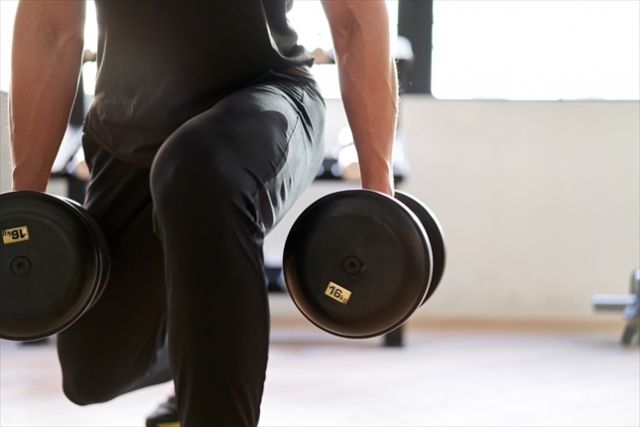
Photo by a まぽ
For more variety, my recommendation is to buy online. Online stores such as Amazon or Rakuten have a humongous variety to choose from. An added benefit of buying protein in Japan is that the Japanese protein companies often do collaboration events with TV shows or anime. So there is a likely chance that your favorite anime has their own limited flavor that you can enjoy before or after a workout.
Finding a gym was another challenge in Japan. In Los Angeles, gyms are found on every corner and are gargantuan. In the Japanese countryside, finding a gym is akin to finding a unicorn. The gyms outside of large cities are much smaller in size, and are often personal trainer gyms, which cost more money and may not fit everyone’s preferred exercise routine.
For people living in the countryside, the prime choice would be to find an Anytime Fitness gym. Anytime Fitness is a 24 hour gym that has locations popping up all over Japan, including the more rural areas.
These gyms are often located near train stations and have easily accessible parking. The facilities are relatively small compared to the usual larger corporate gyms but Anytime Fitness has most of the necessities for cardio or targeting muscle groups. Since gym culture is not as popular in Japan as compared to America, the wait times for using equipment is shortened as well.

Photo by a FineGraphics
An added benefit of living in Japan is how much accessibility there is for pedestrians and cyclists. The roads are usually well maintained and kept clean, so cycling long distances can be done easily, given you are not stationed in a mountainous prefecture. If you were dispatched to a more flat region of Japan such as the Kanto region, I recommend cycling to work when the weather and distance from your school is reasonable. Not only is cycling easy in Japan and commonly done by Japanese citizens, it also is a great extra cardio exercise that will help shed some extra weight.
A nice plus I found is that, compared to driving, cycling is much less stress-inducing. Not sitting in traffic daily and enjoying the beautiful Japanese scenery is great medicine for the heart. Occasionally Japan does have heavy rain, heat waves, typhoons, and snowstorms, so drive when needed. Better to be safe than get just one hour of cycling done.
The transition from a western country to Japan can be jarring at first, but all of the tools to have a healthy lifestyle are readily available. There is so much to see and do in Japan, so make sure your body is just as ready as your mind!
Photo Credits:
Additional photos by まぽ and FineGraphics
All other content (text) created by the original author and © 2023 MUSUBI by Borderlink
Top Photo: キャラメルhanabi on PhotoAC
You have probably heard of Yamanashi as the place where Mt. Fuji is, but one of the best places to go to in Yamanashi is definitely Fuji Q Highland. In Japan, Fuji Q is known as the top 4 amusement park after Disneyland, DisneySea, and Universal Studios Japan. An amusement park that is known for its world record-breaking roller coasters.
ROLLER COASTERS
1. Eejanaika
The first roller coaster I’d ridden, ever. This ride requires you to put your shoes in the locker and I was confused at first, but then it turns out that this coaster is a 4D roller coaster. Not just any 4D roller coaster but World’s tallest and fastest 4D roller coaster. It boasts 14 rotations per ride. With this, keep in mind that you won’t be sitting upright, with only your head exposed. Your legs would be dangling and as you go through some loops, your chair will spin with it. There will be also a time when your chair will be facing backward, and you’ll be lying on your back before a drop. Trying to remember it gives me chills.
2. Takabisha
Dubbed the World’s Steepest Roller Coaster until 2019, this ride has a drop point of 120°. With that, it starts off as a normal roller coaster until it gets to the part where it climbs up the tracks in a straight vertical line and drops on an R-shaped track that makes you feel like the ride will drop straight to the ground but it won’t. I don’t know how it’s a very safe ride, but my heart surely wasn’t.
3. Dodonropa
Was the World’s fastest roller coaster that can reach up to 180 km/h in 1.56 seconds but was sadly closed temporarily.
4. Fujiyama King of Coasters
With its sudden rise, descent, turn, stop, and acceleration, and a classic feel to it. This easily became my favorite. It was the longest and most satisfying ride among the 3 coasters I’ve ridden. It bagged 4 World records when it opened in 1996 and made way for the newer coasters. From here, you can also enjoy the view of Mt. Fuji before or after you start screaming for your life.
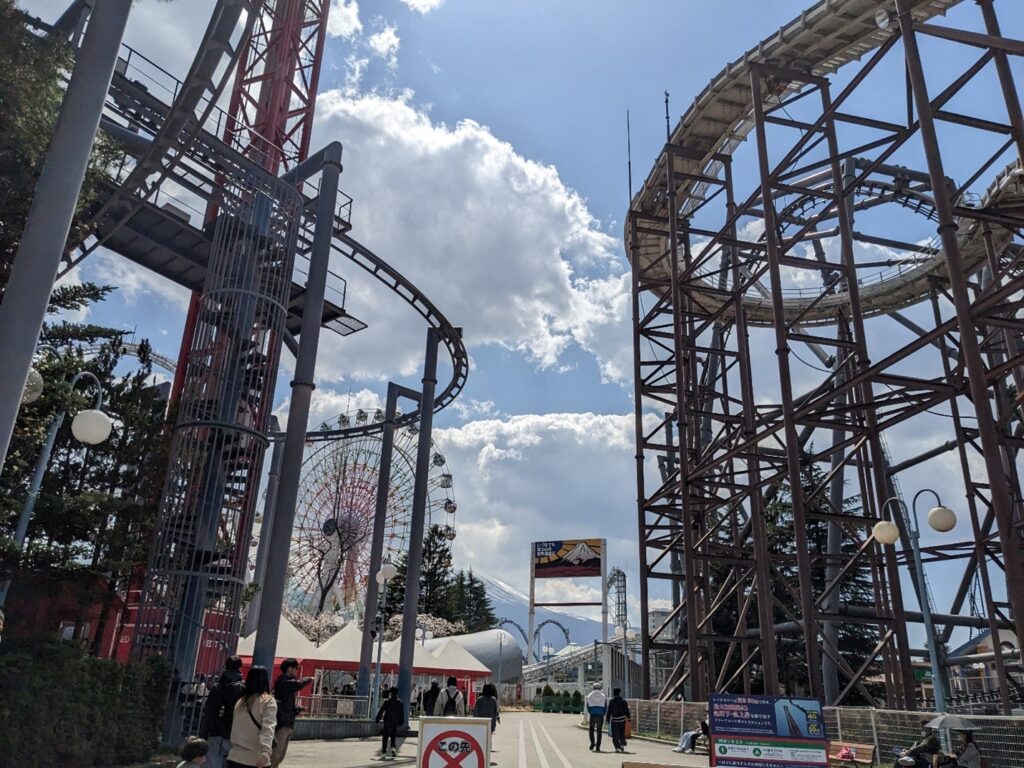
Photo provided by the original author, used with permission.
OTHER ATTRACTIONS
Roller Coasters are not the only attraction you can find in Fuji Q Highland. There are also other intense rides like Red Tower which makes your guts drop, Cool Japan where you might need to buy a rain poncho but if you don’t mind getting soaking wet, they have places for drying, and others that I wasn’t able to try.
They also have a horror house that I wasn’t able to get to but only because the ticket sales are limited and apparently can be sold out in the afternoon. So, if you’re able to go to Fuji Q and are interested in horror houses, please buy a ticket as soon as you can.
CHARACTER-THEMED AREAS
1. Thomas Land
A Thomas and Friends-themed area that is perfect if you have children or are just a fan of Thomas and Friends. This area is filled with different characters and rides that you can enjoy even if you’re just passing by.
2. Fuji Hidden Leaf Village
If you’re a fan of Naruto, go visit the Fuji Hidden Leaf Village that is adorned with Naruto characters and little shops, that make you feel like you’re in a little Konoha.
3. La ville de Gaspard et Lisa
Likes a little French twist while in Japan? La Ville de Gaspard et Lisa is the perfect place. Adorned with French themed establishments and a little Eiffel Tower. You can be in your classy and cute bubble.
SHINING FLOWER
While I wasn’t able to ride all the rides to write about it. I was able to finish my day in Fuji Q by riding Shining Flower, a 50-meter Ferris Wheel. Perfect for a romantic sunset time, to be in awe of Mt. Fuji and see all of Fuji Q and beyond from above. While it shows me all the rides that I wasn’t able to ride, it also showed me the rides that I did, especially the roller coasters. It showed me all the loops in each coaster, the length and the height, and how I overcame my fears upon riding those scary rides.
While my writing doesn’t do justice to everything that Fuji Q can offer. I hope I can get you to be interested and consider it as your next go-to place when you have the time and energy to do so.
ACCESS
From Shinjuku, you can take a bus that goes directly to Fuji Q Highland and purchase a 1-day pass for 6,200 yen. 1-day pass comes with facial registration upon entry, meaning, you don’t need to wear scratchy bracelets or always have to look for your ticket. Your face is your re-entry pass.
Upon entering the park, you can pay for your locker if you’ve brought a lot of things with you but don’t forget to carry your valuables. On some rides, you’ll find that you have to put your wallets, eyeglasses, phones, and such in lockers, but don’t worry as they have lockers you can put your stuff in during the ride.
They also have Priority Tickets for some rides so you can enjoy the rides without the waiting time that you can buy from the machines close to each attraction.
Photo Credits:
Top Photo: キャラメルhanabi on PhotoAC
All additional images taken and provided by the original author, used with permission.
All other content (text) created by the original author and © 2023 MUSUBI by Borderlink
In the enchanting world of Japanese cuisine, one delicacy reigns supreme and has captivated the hearts and palates of food enthusiasts across the globe – sushi. This exceptional culinary creation melds beautifully vibrant aesthetics with an explosion of flavors, making it not just a dish, but an experience.
Originating in the Land of the Rising Sun, sushi boasts an array of tantalizing variations, each one offering a perfect balance of taste, texture, and nutritional value. Known for its delightful taste and artful presentation, sushi offers not only indulgence for the palate but also various health benefits.
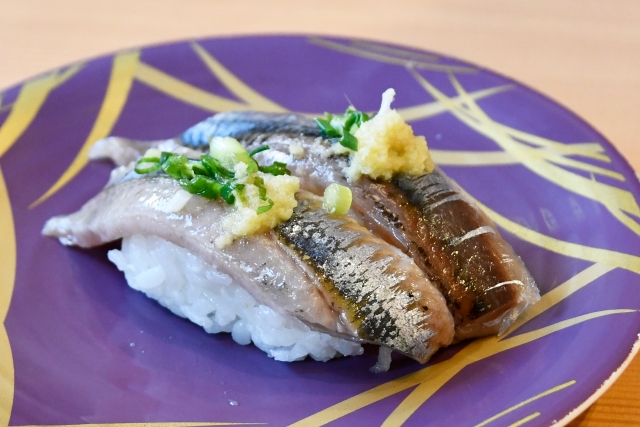
Photo by くまなな
What Makes Sushi
Sushi is primarily made up of raw fish, rice, and vegetables. Fish used in sushi are often rich in Omega-3 fatty acids, which are known to maintain heart health by reducing inflammation and aiding in the prevention of heart diseases.
Another crucial ingredient present in most sushi dishes is wasabi. This green paste, with its strong flavor and pungent aroma, contains antioxidants that help boost immunity and protect against certain types of cancer.
Seaweed – yet another key component in sushi — is packed with essential nutrients such as iodine and vitamins A & C. It contributes to healthy thyroid function, strong bones, and teeth while also showcasing anti-inflammatory properties.
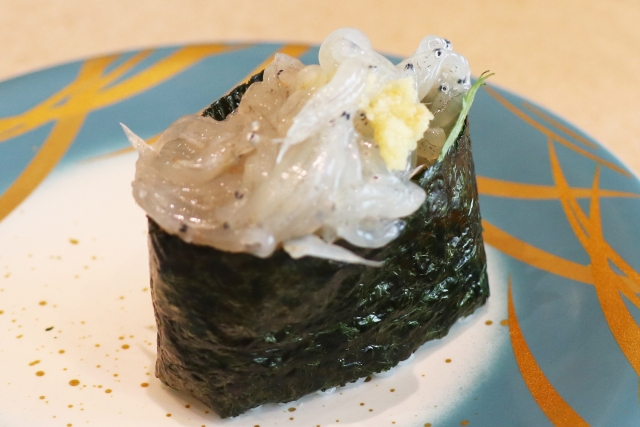
Photo by くまなな
Some Popular Sushi
Now let’s explore some of the most popular types of sushi:
Nigiri: Skilfully hand-pressed vinegar rice topped with a slice of fresh raw fish or seafood. Popular choices include salmon, tuna, eel, and shrimp.
Sashimi: Not strictly sushi since it involves no rice, but is often served alongside it. Sashimi features thin slices of raw fish or seafood such as fresh tuna or octopus neatly arranged on a platter.
Maki: Rolled sushi encased in nori (seaweed) sheets that usually include sushi rice, fish or seafood, and vegetables like cucumber or avocado. A well-known example is the California roll that contains crab meat, avocado, and cucumber.
Uramaki: An inside-out version of maki rolls where rice covers the outside layer, followed by nori and an assortment of ingredients at its core. One popular example is the spicy tuna roll.
Temaki: A conical-shaped hand roll with ingredients partially enclosed by a sheet of nori. This allows diners to enjoy sushi in a more hands-on and informal setting.
Gunkan: Shaped like a small boat, this type of sushi has a bed of rice wrapped in nori and topped with soft-textured ingredients such as roe or uni (sea urchin).
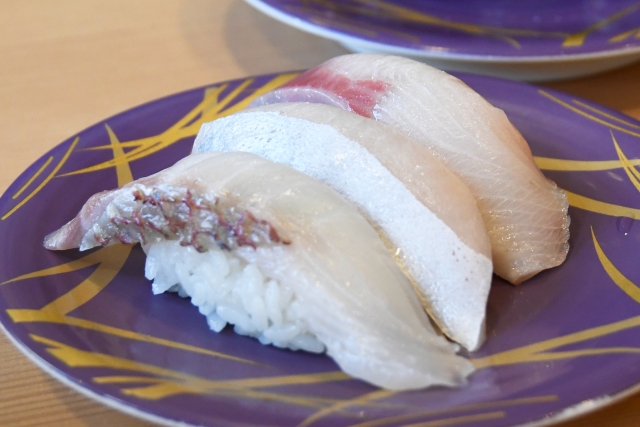
Photo by くまなな
The Art of Sushi
Sushi is not only an art form but also a nutrient-rich cuisine that combines taste and health benefits into one exquisite package. While indulging in this delicious culinary masterpiece, it’s essential to pay attention to the quality and freshness of ingredients to maximize the potential health benefits that sushi has to offer.
From its humble beginnings as street food to becoming an international sensation, sushi has always carried with it a message: that the world can come together and find unity in the shared love for this extraordinary dish. Indeed, like perfectly crafted sushi rolls themselves, we too are woven together by our collective appreciation for this culinary wonder that bridges cultures and transcends borders.
Photo Credits:
Additional photos by くまなな
All other content (text) created by the original author and © 2023 MUSUBI by Borderlink
Fall is my favorite time of year. The unbearable heat of summer with it’s accompanying cicadas make way to to more pleasant time of year. Fall in Japan reminds me of my home in Michigan. Apart from Christmas it is the most festive time of the year. Fall foliage, changing temperatures and seasonal events are awaiting you in Kansai.
The weather during fall in Kansai is more mild than I am used to in the United States. Definitely more consistent. In Michigan we could go from snowing to a perfect sunny day in mere minuets, here is not the same story. While its warmer than most of us are used to the temperature never goes much higher that 80 degrees F.
During the night it will get close to freezing but not quite enough to generate frost for the morning. I recommend to bring a sweatshirt or a jacket that you can take off to school. In the morning the class rooms will be freezing but by afternoon it will feel like a sauna. Be prepared for extreme temperature changes.
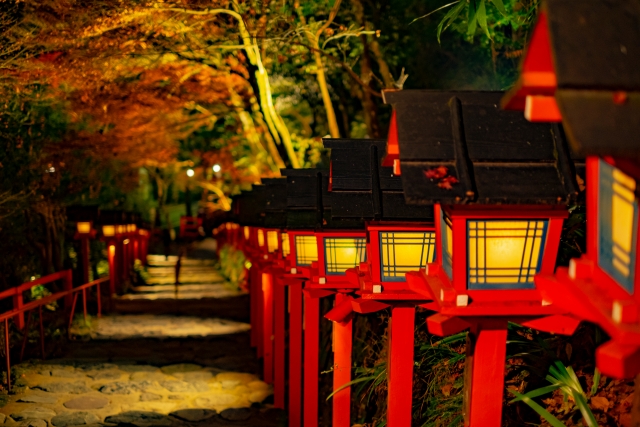
Photo by たかなつ@旅するびぃ
Japan is incredibly beautiful during the fall season and there are many places to see right around here in the Kansai area. Definitely the most famous places to see fall colors is Takayama in Gifu. On the 9th and 10th of October they bring out colorful floats and have a parade around town to celebrate the season.
Furukawa and Gero hot springs are nearby as well. Make reservations well in advance if you are planning to stay nearby. Kyoto is also a very accessible place to see the fall colors as well. The north part of the city the area around Kyomizudera is quite beautiful. You can see all the fall colors on the trees surrounding the temple in the mountains.
Moon viewing or Tsukimi is a very popular even in the autumn season. There is an iconic image of a rabbit looking at the moon eating pounded rice balls I imagine most people are familiar with that is closely associated with moon viewing. It is a popular tradition to bring some snacks such as pounded rice balls and observe the full moon during the autumn season.
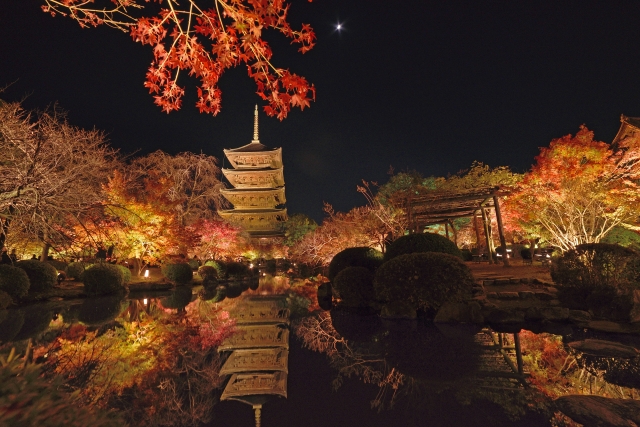
Photo by 恵藤
There are of course several favorite spots. Particularly in Kyoto. People like to go moon viewing where there are vendors for food and drink but this is something that you can see many people doing all around the country even in small towns.
On October 22nd every year you can enjoy the Jidai festival in Kyoto. It celebrates when the capital of Japan was Kyoto for 1100 years. It is a big event with floats and parades. Many people dress up in Heian period costumes.
If you have the opportunity, I highly recommend visiting the Kansai region during fall!
Photo Credits:
Additional photos by たかなつ@旅するびぃ and 恵藤
All other content (text) created by the original author and © 2023 MUSUBI by Borderlink
Top photo: beauty-box on PhotoAC
Introduction
When it comes to living a healthy and fulfilling life, Japan offers a unique blend of traditional practices and modern healthcare systems. From efficient medical services to time-honored customs promoting well-being, this article aims to provide valuable insights and tips for those living in Japan or planning to do so in the future. Whether you’re seeking advice on medicine and doctors or looking to embrace the healthy aspects of Japanese culture, we’ve got you covered.
Accessing Medical Care
Japan boasts a robust healthcare system that ensures quality medical services are readily available. Here are a few essential points to consider:
a. Health Insurance: Obtaining health insurance, such as the National Health Insurance (NHI) or employer-based coverage, is crucial to access affordable healthcare in Japan.
b. Local Clinics and Hospitals: Familiarise yourself with nearby medical facilities, including general clinics (hokenshitsu) and hospitals (byoin), as they play a vital role in providing primary care and specialised treatments.
c. English-Speaking Doctors: In major cities and tourist destinations, finding
English-speaking doctors or clinics can be easier. Utilise resources like the Japan Medical Association’s website or seek recommendations from local expat communities.
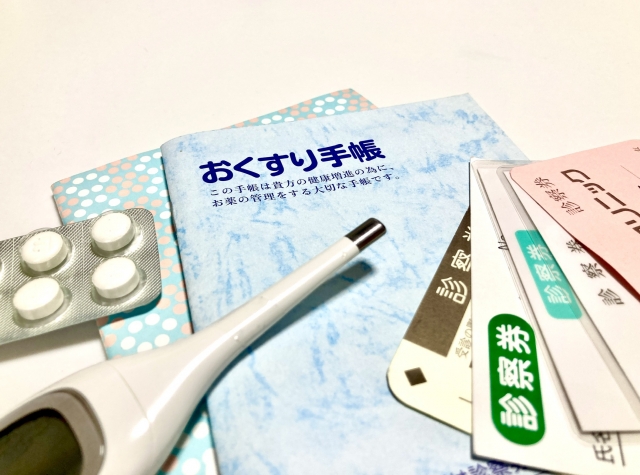
Photo by えのき5858
Medication and Pharmacies
Understanding the process of acquiring and using medication in Japan is essential for maintaining your well-being:
a. Prescription Medication: Certain medications require a prescription from a licensed physician in Japan. Consult a doctor to obtain the necessary prescriptions for your specific needs.
b. Over-the-Counter (OTC) Medication: Japan offers a wide range of over-the-counter remedies for common ailments. Familiarise yourself with popular OTC medications and their recommended usage.
c. Pharmacies (Yakkyoku): Pharmacies are abundant in Japan, marked by a green cross sign. Pharmacists can provide advice and recommend suitable products, even for minor health concerns.
Maintaining Health on a Daily Basis
Japanese culture and lifestyle offer several health-oriented practices that contribute to overall well-being:
a. Balanced Diet: Embrace the Japanese diet, which includes plenty of fresh vegetables, fish, tofu, and rice. This cuisine is known for its nutritional value and can help maintain a healthy weight and reduce the risk of chronic diseases.
b. Active Lifestyle: Incorporate physical activity into your routine by exploring Japan’s natural beauty, engaging in recreational sports, or taking advantage of local fitness centres. Walking is also a popular and convenient way to stay active in everyday life.
c. Onsen Culture: Japanese hot springs, known as onsen, offer relaxation and potential health benefits. These natural hot baths help relieve stress, improve blood circulation, and alleviate muscle fatigue. Remember to follow the etiquette and guidelines when visiting an onsen.
d. Mindfulness Practices: Explore traditional Japanese practices like Zen meditation, tea ceremonies, and flower arrangement (ikebana) to cultivate mindfulness, reduce stress, and promote mental well-being.
e. Health Checkups: Take advantage of regular health checkups (kenkō kensa) offered through your workplace or local government. These screenings help detect potential health issues early on. If you are sexually active you should also get checked at sexual health clinics once or twice a year.
f. Hygiene Practices: Follow proper hygiene etiquette, such as regular handwashing, to prevent the spread of illnesses and maintain personal well-being.
g. Get a good night’s sleep: In fast-moving hard-working Japan, it can be easy to push ourselves to subsist on lots of caffeine and minimal sleep. But this only leads to exhaustion and, at worst, death by over work (karoshi). So be sure to always get enough shut-eye!
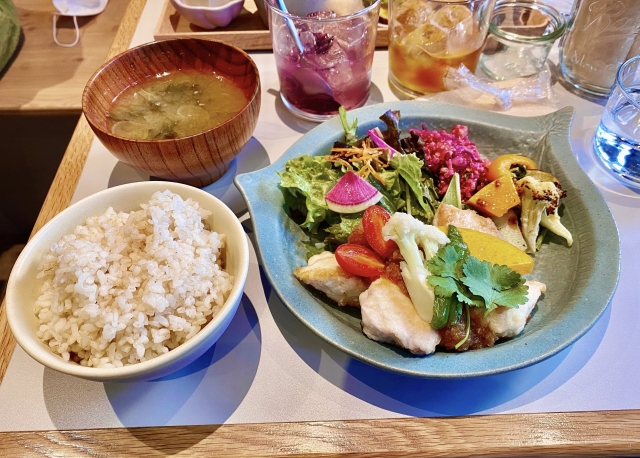
Photo by こーた515
Conclusion
Living in Japan offers a wealth of opportunities to embrace a healthy lifestyle while benefiting from a well-established healthcare system. By understanding how to access medical care, navigate pharmacies, and embrace the healthy aspects of Japanese culture, you can prioritise your well-being and make the most of your experience in this fascinating country. Remember to seek professional medical advice when needed and embrace the blend of ancient traditions and modern healthcare practices that Japan has to offer!
Photo Credits:
Top photo: beauty-box on PhotoAC
Additional photos by えのき5858 and こーた515
All other content (text) created by the original author and © 2023 MUSUBI by Borderlink
